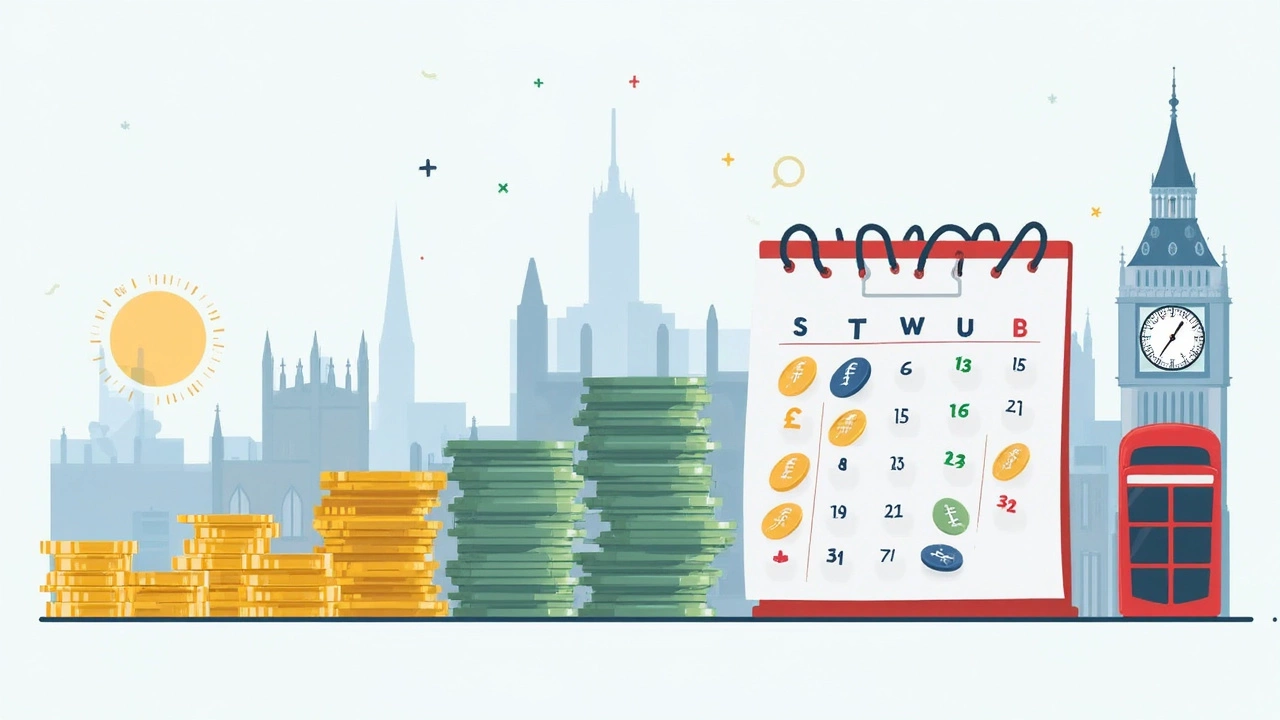Thinking about grabbing a $5,000 personal loan? The first question that pops up for most folks—“What’s my monthly payment going to be?” Let’s skip the vague answers and get right to it. Your payment isn’t random; it depends on the loan’s interest rate and how quickly you pay it back. Lenders will look at your credit, and they'll set both the rate and the repayment window based on what they see.
The numbers can surprise you. For example, if you’re offered a 10% annual interest rate and choose a three-year payoff, you’re looking at about $162 per month. Stretch it to five years, and that drops to around $106 monthly. But, and it's a big but, the longer you take, the more interest sneaks onto your total. So, lower payments feel easier, but you might pay hundreds more just for the privilege of going slow.
- What Determines Your Loan Payment?
- Breaking Down the Numbers on a $5K Loan
- Ways to Score a Lower Payment
- Tips to Avoid Surprises Down the Road
What Determines Your Loan Payment?
There’s no mystery here—your monthly payment on a personal loan like a $5000 loan comes down to a few main things. Your credit score, the interest rate, and the repayment term do most of the heavy lifting. The lender takes one look at your credit score—if it’s high, you’ll snag a lower interest rate. If it needs work, expect a bump in the rate and, you guessed it, a higher monthly payment.
- Loan Amount: Pretty straightforward—the more you borrow, the higher the payment. Here, we’re talking $5,000.
- Interest Rate: This is what the bank charges for lending you money. Rates for personal loans can range anywhere from 6% for folks with excellent credit to above 25% for weaker scores.
- Loan Term: Want to pay it off fast? Shorter terms (like 2 or 3 years) mean bigger monthly hits, but less in interest overall. A longer term (like 5 years) drops your payment, but interest adds up over time.
- Fees: Some lenders tack on origination fees or other costs. They might roll these into your loan or charge them upfront. It's smart to check before signing anything.
Check out this quick comparison. Here’s what the monthly payment might look like at different interest rates over a three-year loan term:
| Interest Rate | Monthly Payment (3 Years) |
|---|---|
| 7% | $154 |
| 10% | $162 |
| 15% | $173 |
So yeah, a tweak in the rate can save—or cost—you big time. If you’re shopping for a $5000 loan, knowing these basics lets you play the field and score the best deal for your budget.
Breaking Down the Numbers on a $5K Loan
If you want to know what you’ll pay for a personal loan of $5,000, you need to look at three things: the interest rate, the length of the loan (called the term), and any extra lender fees. The interest rate is king here. Right now, as of 2025, interest rates for personal loans float between 8% and 20% for most people. Got excellent credit? Expect something near the bottom of that range. Average credit? You’re closer to the top.
Let’s do the math. Here’s how monthly payments shake out if you borrow $5,000 at different rates and terms. No guesswork, just plain numbers:
| Loan Term | Interest Rate | Monthly Payment | Total Interest Paid |
|---|---|---|---|
| 3 Years | 10% | $162.37 | $845.32 |
| 5 Years | 10% | $106.24 | $1,374.53 |
| 3 Years | 14% | $170.68 | $1,144.37 |
| 5 Years | 14% | $116.56 | $1,993.33 |
Notice how stretching the loan to five years drops your monthly cost but nearly doubles the amount you fork over in interest. A shorter loan pinches your budget more every month, but you save hundreds in the long run.
And about fees—always check for origination fees. Some lenders toss on a one-time fee of 1% to 8% of your original amount, which gets taken out before you see the money or rolled into your payment.
Want to see your own numbers? Most banks and online lenders have personal loan calculators. Punch in the loan amount, play with the interest rate and term, and you’ll get an instant peek at what your monthly payment would look like. You can even test what happens if you make extra payments—sometimes just $20 a month more will save you a huge chunk on interest.

Ways to Score a Lower Payment
Every dollar counts when it comes to paying back a personal loan. Even a small drop in your monthly bill can mean extra breathing room. So, how do you actually pull that off?
- Boost Your Credit Score: Lenders hand out the best rates to people with higher credit scores. Even moving your score up by 20 points could save you money. Pay off any small debts, zap late payments, and check your credit report for errors before you apply.
- Shop Around: Don't just grab the first offer you see. Each lender has its own way of sizing you up. Get quotes from online banks, credit unions, and even your local bank. Some apps will even soft-check your credit, so you can see rates without hurting your score.
- Pick a Longer Term—Carefully: If you really need a lower monthly payment, stretching your loan out to four or five years does the trick. Just watch out, because you’ll pay more interest over time. Make sure it actually fits your bigger budget plans.
- Take Only What You Need: Don’t borrow $5,000 if you only actually need $3,000. It sounds basic, but lenders tack on interest for every extra dollar you borrow. Borrow less, pay less—simple math.
- Look for Discounts: Some lenders drop your rate if you set up automatic payments. That could shave 0.25% off your interest rate which, on a $5,000 personal loan, shaves a few bucks off each month.
Here’s a quick look at how the numbers can shake out, just by changing your loan term and interest rate:
| Loan Term | Interest Rate | Monthly Payment |
|---|---|---|
| 3 years | 10% | $162 |
| 3 years | 7% | $154 |
| 5 years | 10% | $106 |
| 5 years | 7% | $99 |
See how a lower rate or a longer term changes things? Always double-check total interest paid, though. Keeping that monthly number low is nice, but don’t pay double just for small payments.
Tips to Avoid Surprises Down the Road
No one likes getting blindsided by a bill, especially with something as big as a personal loan. If you don’t want your $5,000 loan to come packaged with headaches, here are some tried-and-true ways to keep things smooth.
- Check for hidden fees. Some lenders sneak in origination fees, prepayment penalties, or late charges. Ask for the total cost upfront—and get it in writing.
- Understand your interest type. Is your rate fixed, or can it go up? A fixed rate keeps your monthly payment steady. A variable one can jump, making your payments unpredictable down the road.
- Know your loan term. Shorter terms mean bigger monthly payments but less paid in interest. Longer terms give you a break each month, but you end up paying more if you don’t pay early.
- Look at the payment due date. Some lenders let you pick your payment day. Try to set it close to payday, so there’s never an ‘oops’ later on.
- Automate your payments. Setting up autopay helps avoid late fees, and some lenders even give a small interest discount for it. Easy win.
Here’s a quick peek at how fees and interest can change the total on a $5000 loan:
| Scenario | Term (Years) | Interest Rate | Total Paid |
|---|---|---|---|
| No Fees | 3 | 10% | $5,813 |
| $200 Origination Fee | 3 | 10% | $6,013 |
| 5-Year Term | 5 | 10% | $6,370 |
Just because a lender offers a shiny low monthly payment doesn’t mean you’re scoring a deal. Always look at the total you’ll pay by the end. This way, you won’t wake up years later and realize you signed up for more than you bargained for.
If you get stuck, reach out to your lender early. Most are willing to work with you if things get tight—just don’t wait for the first late notice.

